Limpkins! (Aramus
guarauna)
This page started 04/01/2022
from material I posted earlier on other pages. Rickubis
designed it. (such as it is.) Last update: 11/15/2024
Images and contents on this
page copyright ©2021- 2024 Richard M. Dashnau
Go back to my
home page, Welcome to
rickubis.com
Go back to the RICKUBISCAM
page.
I
was introduced to Limpkins when I heard about their appearance at Brazos
Bend State Park. I learned that they probably followed the invasion of
Apple Snails (Pomacea sp.)
across the Southwest states until they appeared in Texas. I learned about
and saw Apple Snails first, and the information I've gathered about them
is on my Snails Page.
I've
learned that although the circumstances which brought the Limpkins here
isn't so good (invasive snails), the fact that we can watch them in
different places, here in Texas, is
really amazing. It appears
the Limpkins have only been here a few years so far. So, I'm collecting my
images/videos here so others can see them. The latest additions will
be at the top of the page.
11/03/2024
At
BBSP, while
walking on the
Spillway
Bridge around
8:30am; I'd
been hearing
Limpkins
calling to the
South. But
they were far
away, and out
of sight. I'd
stopped
on the
bridge to just
look around.
The view to
the South now
shows parts of
the "mile
stretch"
section of the
road--which
hadn't been
visible until
recently. After
seeing a
Spoonbill. I
finally found
one of the
Limpkins about
40 minutes
later. I
was still on
the bridge,
because it was
a nice
morning. The
Limpkin was
even further
away than the
Spoonbill was.
But I tried
some photos
for that, too.
It was to my
left, or
Southeast of
my position,
at 9am. I was
looking almost
towards the
Sun, and it
brightened the
outline
of the
Limpkin. This
was just the
second weekend
that I'd heard
Limpkins in
the park after
a year
or so.
The last 3
summers have
been brutally
dry. Hurricane
Beryl and the
rain a week
after
helped
replenish some
of the water
we needed. The
presence of
the Limpkins
was a
good sign.

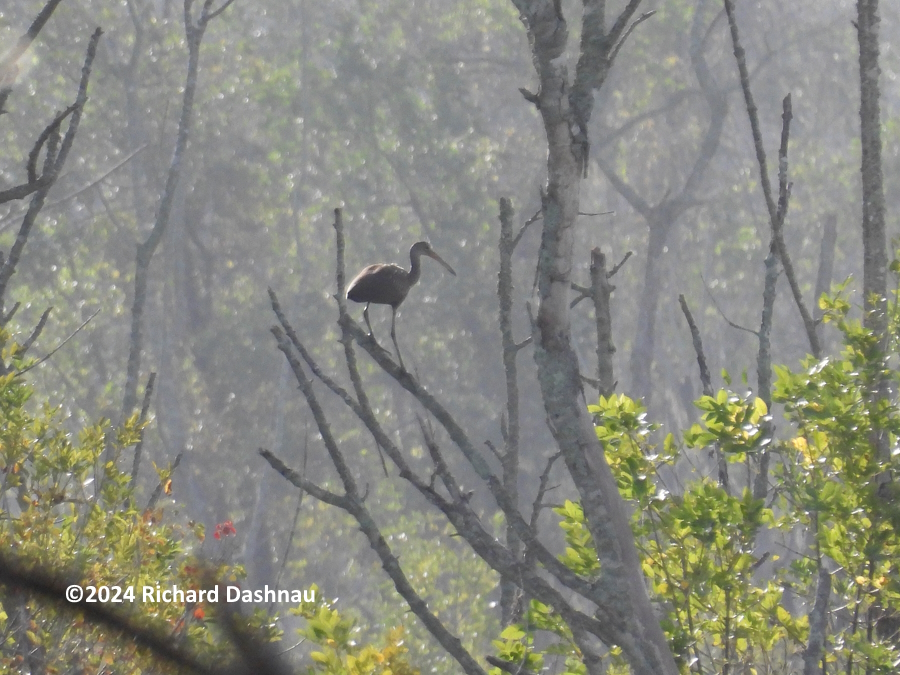
03/19/2023
A cold front had passed through
recently. That morning, the thermometer in my car showed 47°F. I didn't
bother trying to record the
air
temperature on the trail because I was
trying a new piece of equipment that I thought would give me
related data. I can say that it felt REALLY cold out there.
Limpkins
were
first reported in Texas in 2021. They've been hunting
in Brazos Bend State Park since then, usually around Live
Oak Trail (and the property next door) during the Summer.
When
Live
Oak Trail dried out last year, the Limpkins stayed near
the
lake next door to BBSP, but a few foraged in Elm
Lake.-which is about 1/2 mile from where the Limpkins were
on Live Oak Trail.
I've
watched them in this corner of the lake, and found out
they were eating mussels.
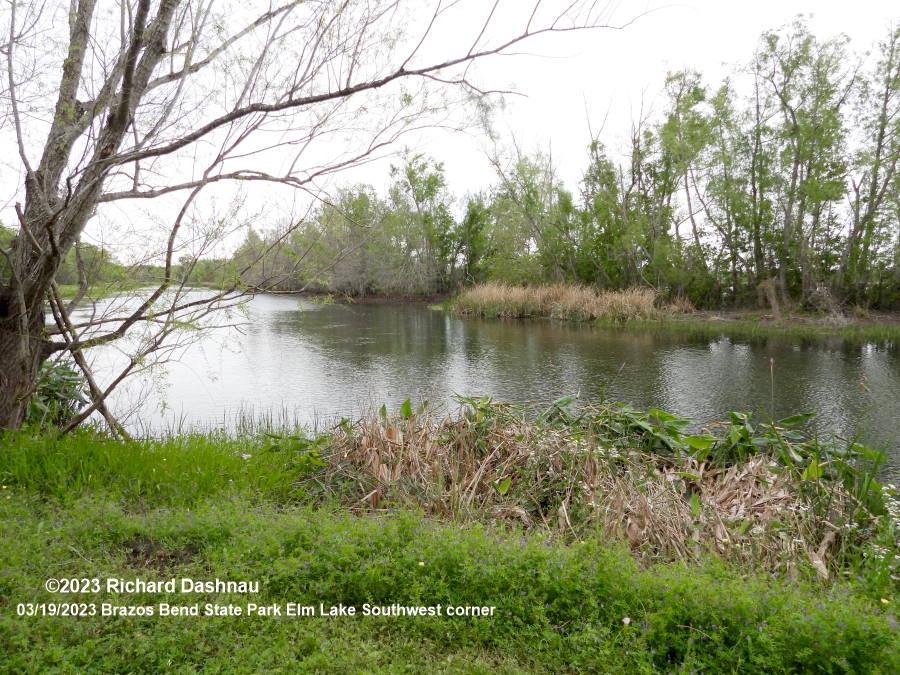


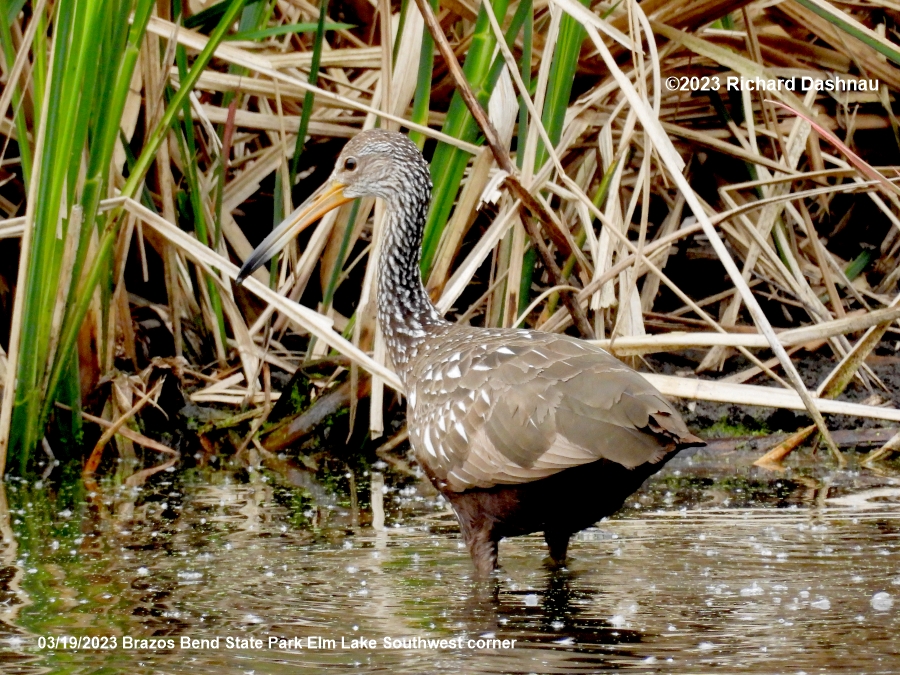
Limpkins
are "mollusk specialists", and are adept at opening many types
of shells. I was happy the first time I got to see a Limpkin
eat a mussel a few weeks ago. On this day, I watched
this
Limpkin capture at least
6
mussels over 45 minutes, and was able catch some of that on
video. That's what will show here. The Limpkin was
hunting along the near bank of that island across
the way (about 50 yards
from
this trail). When the Limpkins hunted along Live Oak Trail,
they probed with their beaks, similar to the way Ibises do.
It seemed to be mostly blind probing in
murky water with dense vegetation. But this one seemed to be
hunting with its eyes, visually inspecting the water, similar
to Herons or Egrets. the frequent probing at Live
Oak Trail. Pictures
and video clips of the Limpkins on Live Oak Trail are on
further down on this page.
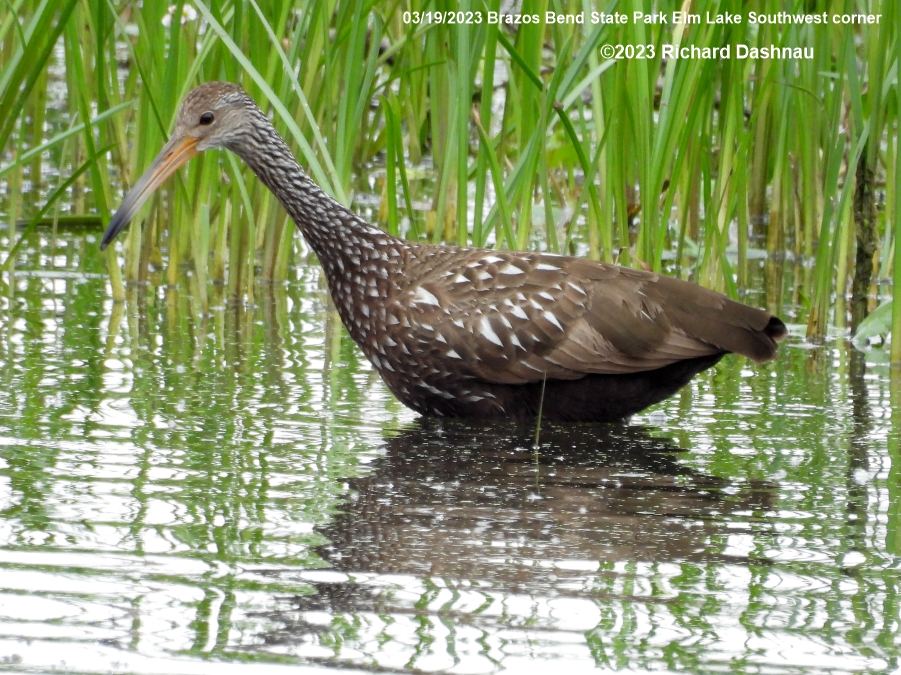



I
caught multiple videos of the entire process-from capture to
cleaning the last morsels out of the shell. The procedure as I
saw it: 1)Hammering at the mussel-this seems to be aimed
at the
outer edges of the closed shell, possibly to chip off
the edge so the beak can be pushed in. 2)Standing the shell
and trying to push the beak between the halves. 3) Once part
of the beak is in,
move it around to disrupt the mussel until both jaws get in so
that the shell-closing muscles can be cut. 4) Now the mussel
shell lies open. Time to snip the good parts away from
the shell.
Small bits are pulled from the shell and tossed, although a
few are swallowed. 5) The main body is pulled out, shaken a
bit, then swallowed without ceremony. 6) A bit more
cleanup of the shell
and surrounding to pick up any missed scraps, and then off to
hunt for the next one. Someday I might pull frames from
the video to illustrate that procedure here, but not today.
For now, it's
visible in the edited video. By the way, note
all of the discarded mussel shells in a few of the pictures
below. Wow! So, even though the day was cold, damp, gray
and pretty miserable-it was
worth going out on the trails that day.

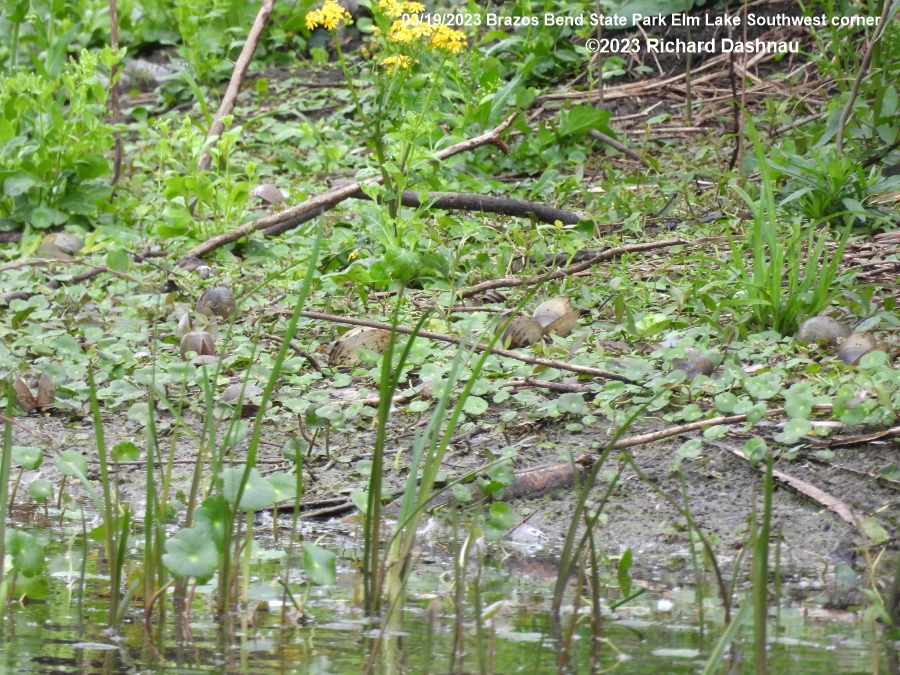
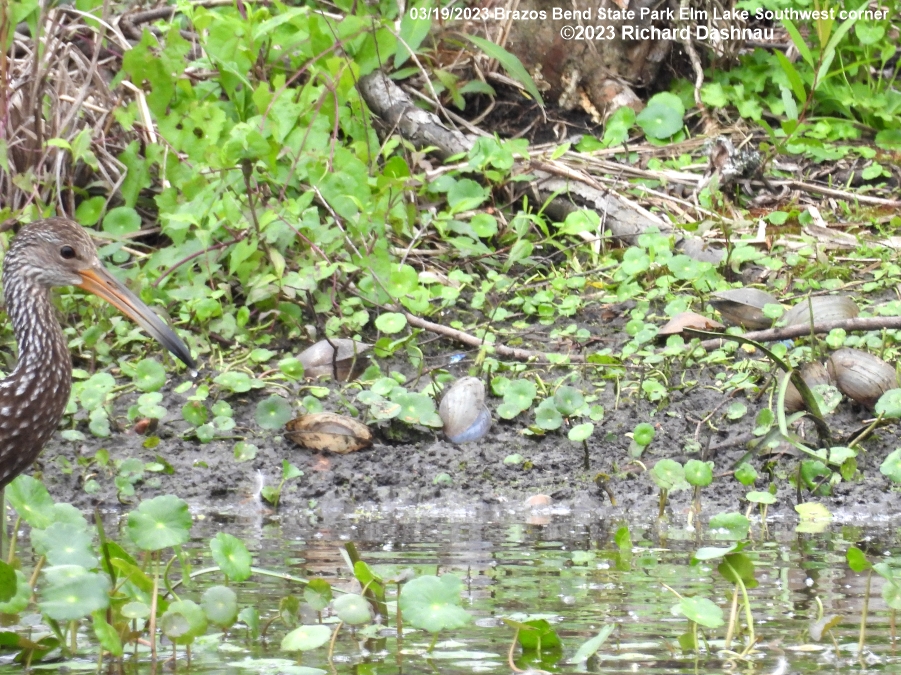

On 01/15/2023 I was at BBSP, and it was an
interesting day. Herons and limpkins! At
11:00, one of the park visitors pointed out that a Limpkin (Aramus guarauna) was
foraging near an
island in Elm Lake.
I'd
have never noticed it otherwise, since a group of
Black-bellied Whistling Ducks were lying around and swimming
there, and the Limpkin was among them.




The Limpkins had been hunting along Live Oak Trail through
2021 and 2022.
They seemed to leave that area during drought in the Summer
of 2022, and one was seen briefly in Elm Lake then.
I was happy to see this one, and wondered if it would get
lucky, since they prefer to eat molluscs. The Limpkins
have moved into Texas because of large numbers of Apple
Snails (Pomacea sp.)
that have appeared here. To our knowledge, there are still
no Apple Snails in Elm Lake (no egg cases visible).
But the one seen in Elm Lake in 2022 was eating
mussels. And...this Limpkin
found a freshwater mussel, too!




The Limpkin's meal remained partially hidden by a bump in
the ground. I was happy to see the process anyway. The
images below are frames from video.
The
edited video is here .



From
BBSP on 05/29/2022
For now, more Limpkins. As usual, lots of things were
going on out at the park. I spent about an hour on Live Oak
trail, and watched
the Limpkins. Conditions along that trail have been getting dry
over the last few weeks, so the Limpkins were foraging at least
25 yards away from me--although they were North of the
trail. That is, between Live Oak Trail and the Park Road.
This video link will let the viewer spend
about 4 minutes with some of the Limpkins I saw.




As noted elsewhere on my pages,
during dry times Apple Snails (Pomacea sp.) can aestivate by
burrowin into the mud. One study showed that they could live
that way for 10
months.
One of the snails that was retrieved by a Limpkin was
covered with mud (I didn't recognize it was a snail at first).
Perhaps it had been trying to burrow. No--not the one in
the image below.


On 4/10/2022,
I'd signed up to lead a hike and other tasks, so I went out to
LIve Oak Trail early to look for Limpkins. I got to watch some,
and here are
the images. I still haven't caught close shots of Limpkins
dissecting snails, but there is some of that shown at distance
in the video I got. There are also a few closeups of the
Limpkins'--and
Ibis'--dipping behavior while foraging.
I believe that "dissection" is an appropriate term for what the
Limpkin is doing to the snail. When viewed in realtime,
movements are so quick, that
the quick twisting and flicking doesn't reveal what is
happening. But if the video is slowed down, then it's possible
to see that the Limpkin is using its beak with precision, and is
tweezing
away small bits of snail flesh, and then tossing them aside. In
the slowed video, some of the bits are visible, and some may be
pink. I believe that the Limpkin is rejecting bits based on how
they taste. In the video I captured, bits were snipped and
tossed...until one bit was pulled off and eaten. The rest of the
carcass was eaten right after that.
The edited video is at this link.
Also, if pictures of one
Limpkin is good--then a picture of two Limpkins must be better!
So, they're here, too.
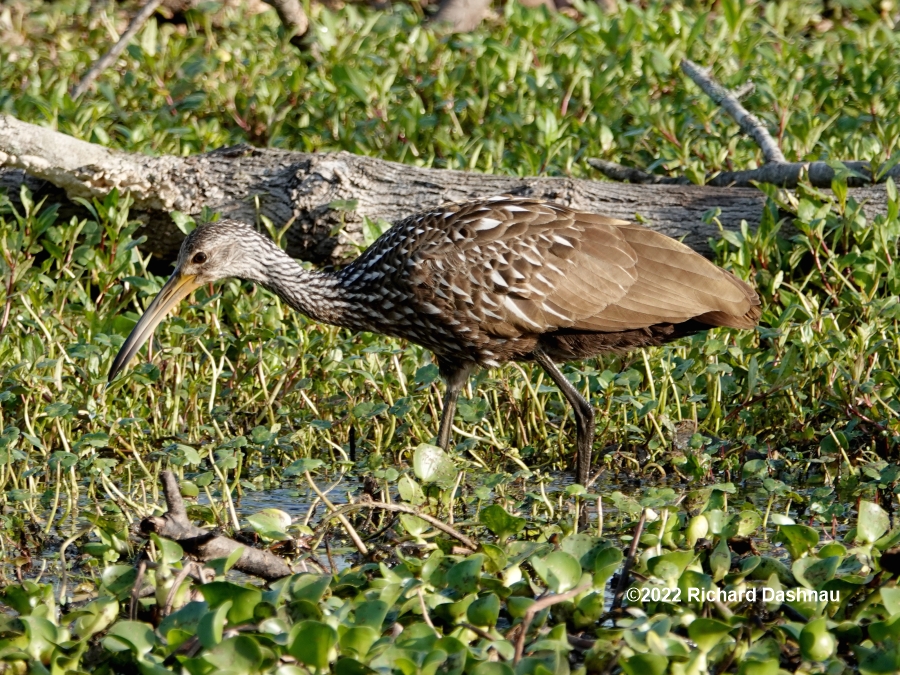
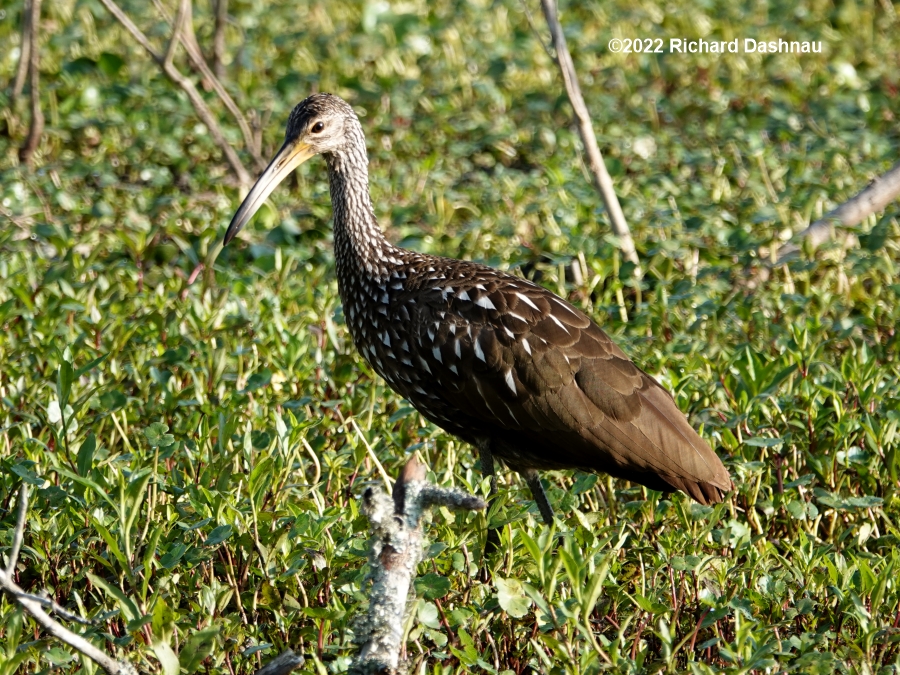


Many folks
describe a Limpkin as being about the size of an Ibis. Today,
a White Ibis (Eudocimus
albus) foraged
next to a LImpkin, so I got some direct comparisons. The two
birds foraged
next to each other, and I could watch them both probing for
food with their beaks. Clips of them foraging together
are also in the edited video.
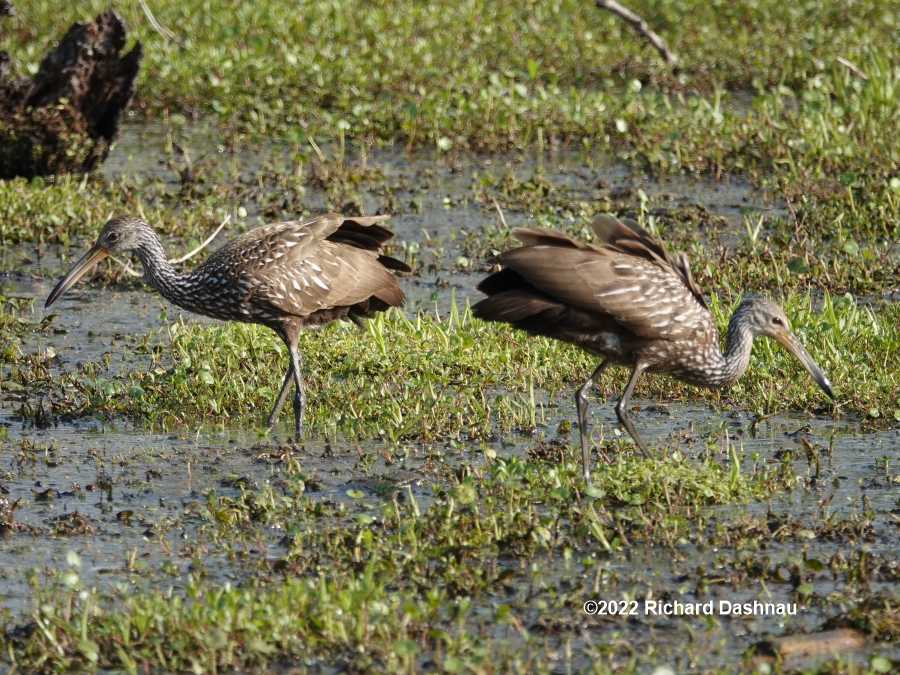

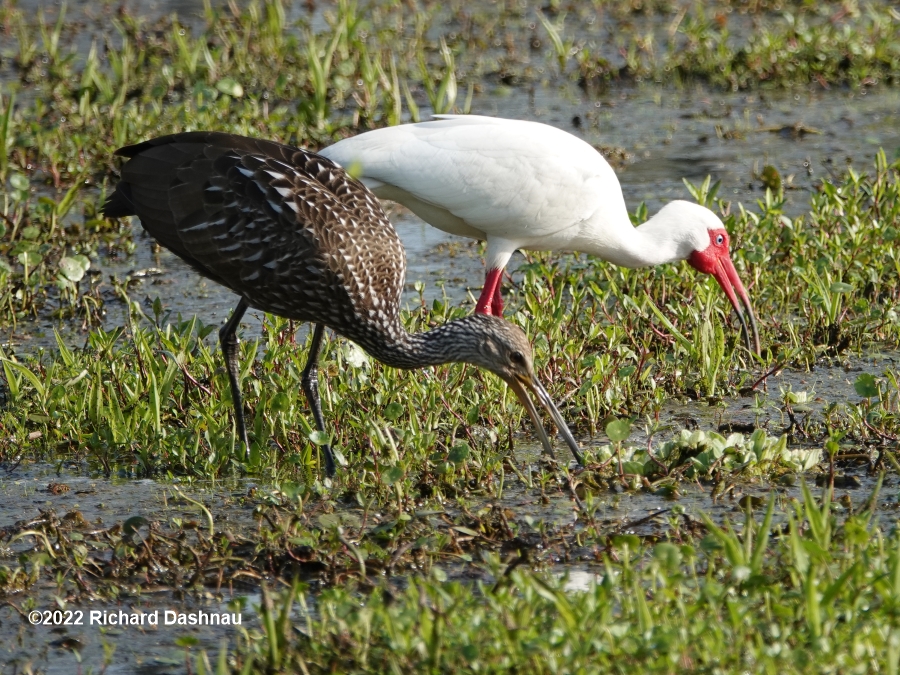

From BBSP on 04/03/2022.
More with the Limpkins! I was on Live Oak trail
around 8:30am. There weren't very many Limpkins active there
yet, but I did see a few.
One was calling from a
tree across the lake that is outside the Southern boundary
of BBSP. I shot video of that to show how far that sound
carries. About 30 minutes later, The
Sun started
breaking through the
clouds, and more Limpkins began hunting North of the
trail. I was briefly distracted by watching a Great Blue
Heron hunting successfully, but returned to the Limpkins
for these images and
video. The images below are a mixture of still photos
and frame grabs from the video clips. The video clip is here.


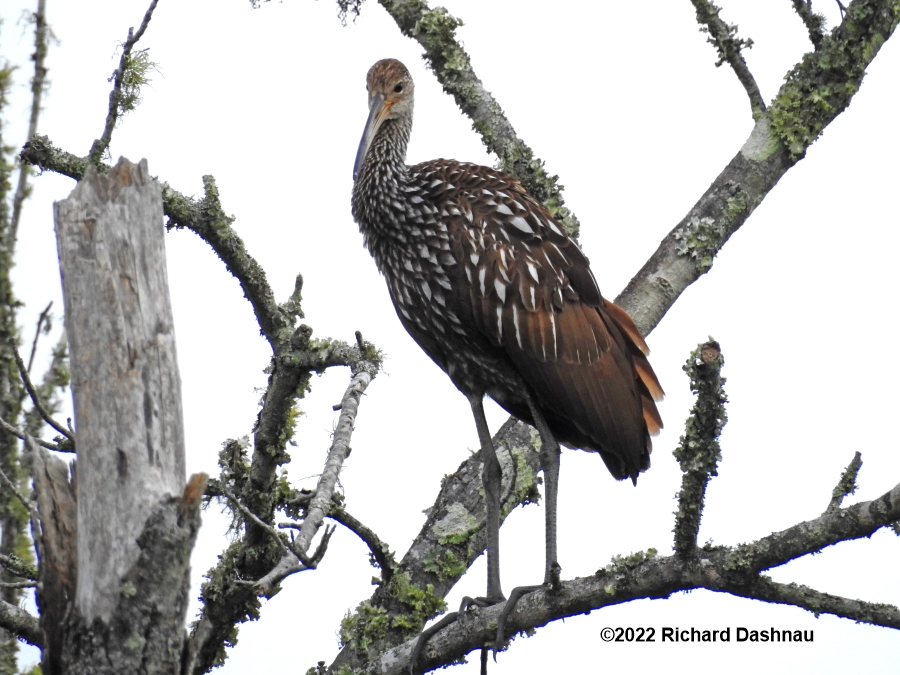

I was able to
get some nice close views of Limpkins hunting, but a clear
view of the Limpkins breaking into the snail still eluded me.
I also found this report on line:
"Natural selection by
avian predators on size and color of a freshwater snail
(Pomacea Jagellata)" 1999 by Wendy L. Reed and Fredric J.
Janzen. The research was done in Costa Rica,
but involved Snail
Kites and Limpkins. The predation was on Apple Snails, but a
different species. Size and behavior of the snails seems to
be the same as our problem P. maculata though.
Among points in the
report I found interesting: 1) Snail
kites rely on visual cues while hunting by
flying slowly across a marsh or hovering while searching for
snails. Limpkins rely on tactile cues
during foraging
by probing beneath vegetation and on the bottoms of marshes
for apple snails. 2) Individual Limpkins differed in the
size of snails they consumed, and in their choosing to
puncture shells before
consuming snails. No single foraging pattern is
exhibited by all Limpkins in this study area. 3) As snails
age and grow, they change their vertical distribution their
primary
behavioral defense
against predators. Large apple snails spend more time at the
water's surface. The change in size is accompanied by
changes in behavior. Larger snails respond to
mechanical
disturbances by dropping off vegetation and burying
themselves in the substrate quicker than small snails do.
4) Limpkins may prefer snails of average size
due to decreasing
energy gains at either
end of the snail size distribution. Limpkins were more
likely to puncture shells of large snails compared shells of
small snails. This shell-puncturing behavior suggests
that large snails may
be more difficult to handle, requiring additional time and
energy to puncture the shell and obtain a meal. The optimal
prey size for Limpkins might then be those snails small
enough not to
require a hole to procure a meal, but large enough to
provide a worthwhile effort.
The report added a bit more perspective to some of behavior
I've recorded. I can see how a Limpkin might have a
harder time "pincering" a large snail in its beak and carrying
it, so puncturing
it would make it easier to carry. But I've seen that the
Limpkins have carried the shell out of the water and to a
solid base to give support the snail shell during the stabbing
attack. I think piercing
the snail weakens it and the muscles holding the operculum
closed, and allows the Limpkin to get under that "trap door"
to tear it off. In one of the other clips from this day,
I show what happens
with a really small snail (three images below right).
The Limpkin set it down, prodded it a bit (and it was
too small to get a beak tip into) then tried to smash the
snail with the tip of its beak. The
snail was knocked into the air and fell in the water and was
lost to the Limpkin.




A
bit later, the Limpkin found a larger snail. The snail was
carried to a more solid platform. .
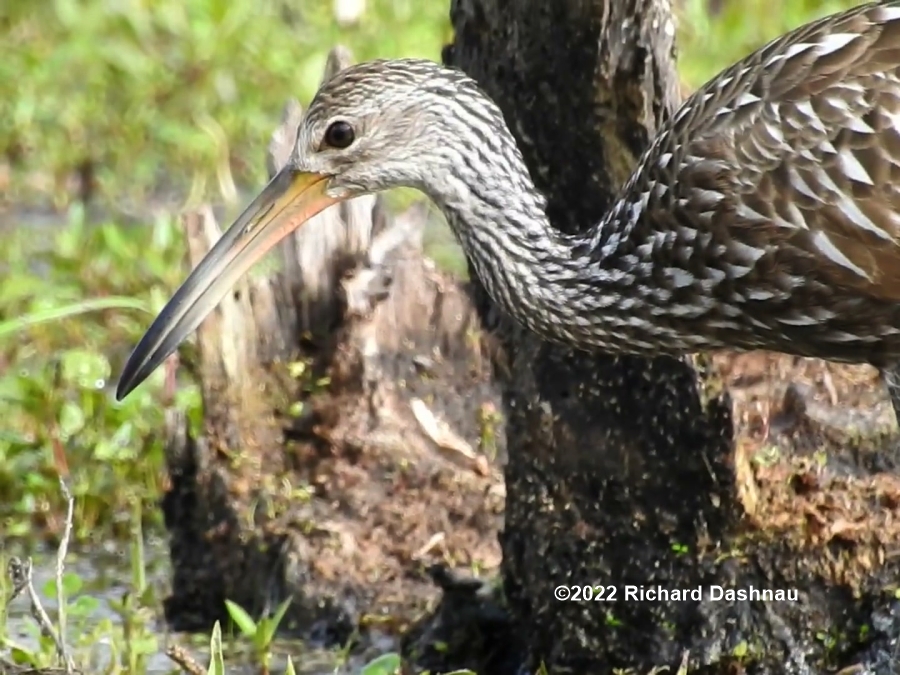

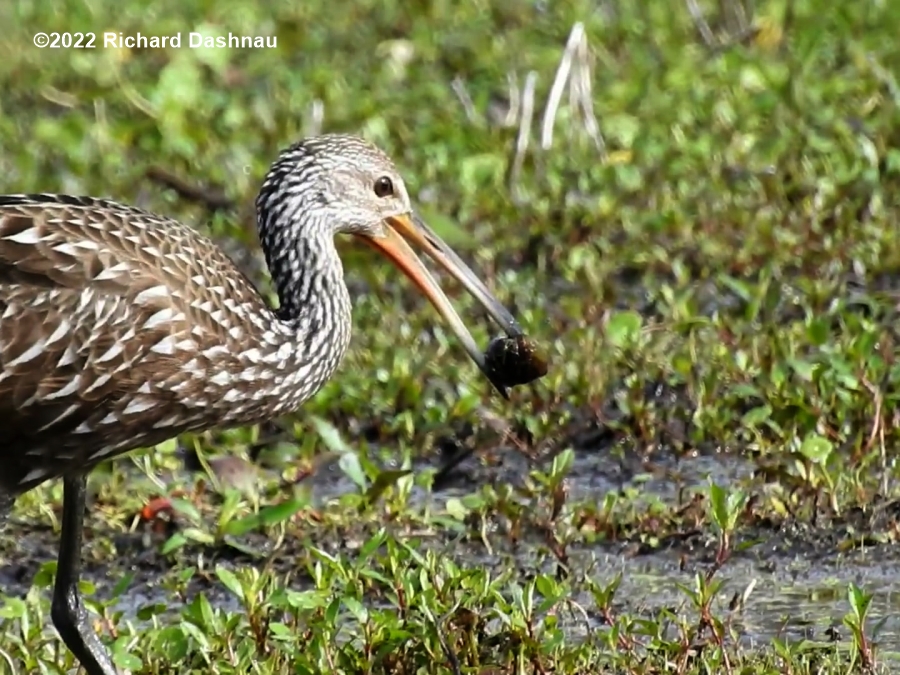

I
could see the Limpkin working on the hidden snail. It
alternated delicate probing with hard stabbing.
Movements changed as the snail's body was exposed. There
was vigorous rapid movenents
of the beak as the snail body was pulled free. Viewed in
realtime, the movements are very quick, and barely noticeable,
but with slowed down video, the amount of movement is
impressive.
What was being shaken free? Was it shell fragments,
detritus, maybe the toxic yolk glands? I can't identify the
fragment the seemed to fly off the snail as it was being
shaken.. The Limpkin
didn't immediately swallow the snail either. It tossed the
meat to the back of its beak, seemed about to swallow--then
spit it up and shook it a few more times before swallowing
it. Finally, I
caught a quick view of a Nutria "photo bombing" the scene.
Again,
The
video clip is here.




Update 04/01/2022 - From BBSP on
03/27/2022. I'd
last seen Limpkins on Live Oak trail last October (2021).
Since then, less Apple Snails (Pomacea maculata) and egg
masses were
observed on or near the trail. Over the winter, no snail
eggs appeared on Live Oak Trail so I stopped going there
because I thought the Limpkins wouldn't be
active. Sometimes I could
still hear Limpkins calling from this area even while I was at
40 Acre Lake. The lake just
across the South park boundary contains the main snail
infestation. With the warmer weather,
I checked the trail for snail eggs. No egg masses yet,
but the Limpkins were around. Two Limpkins were resting
on top of the floating plant mats about 40 yards away, along
with a few
scattered snail shells. I watched another one as it
hunted. This was the first time I got to see the
Limpkins foraging! Widely-splayed toes help distribute the
Limpkins' weight as they stride on
floating plants. Their constant probing for prey
reminded me of the similar behavior of Ibises. Success!
Jackpot! A big snail was discovered as turtles and I watched.
The Limpkin moved to a firm
surface so it could pierce the snail. It placed the snail,
then attacked it with short, accurate and powerful strikes.
Most of the images here are frames from the video clips I
shot.
The video clip is here.
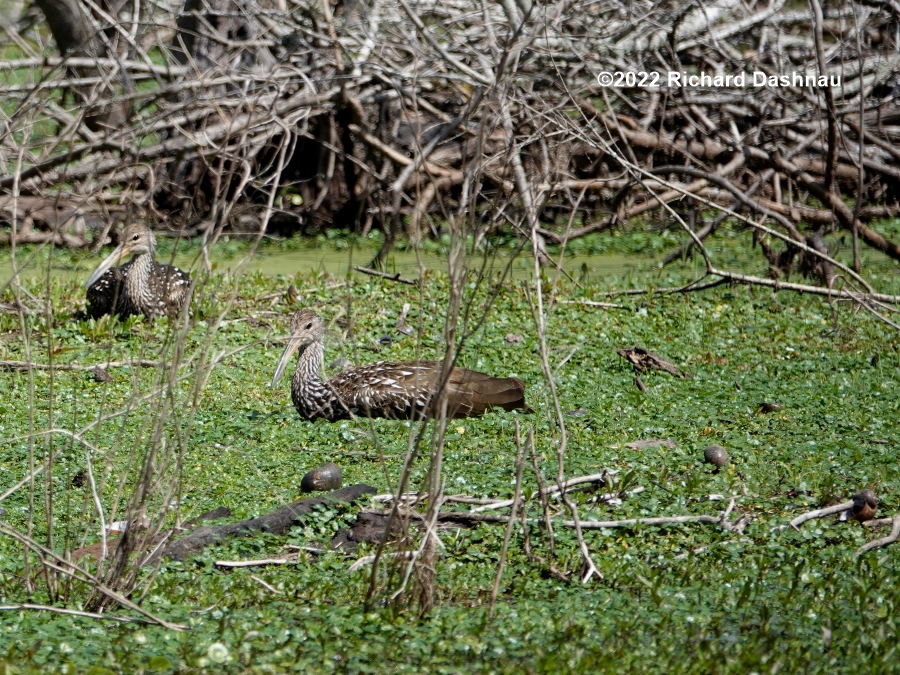
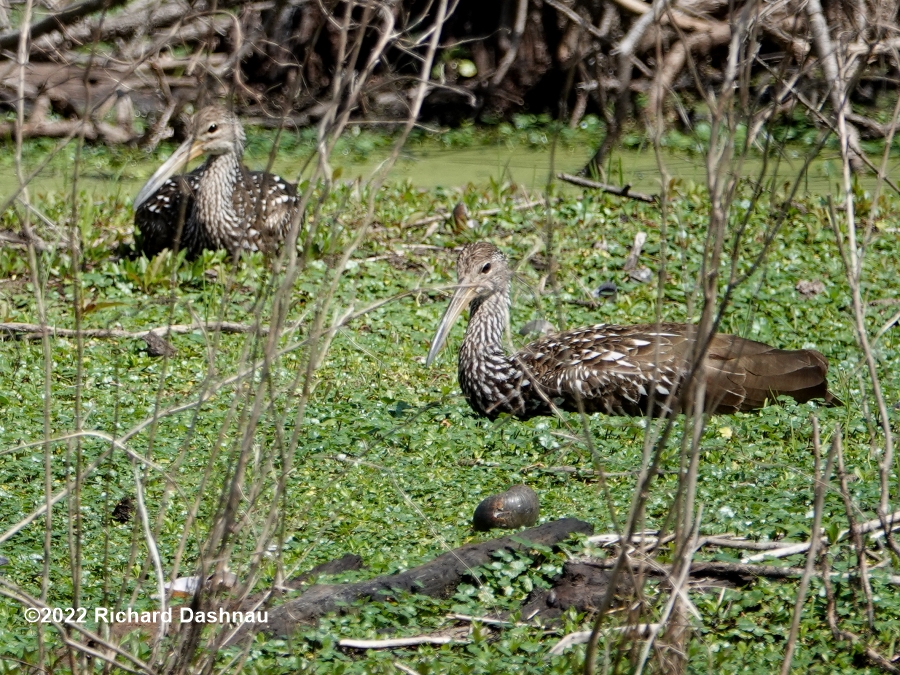

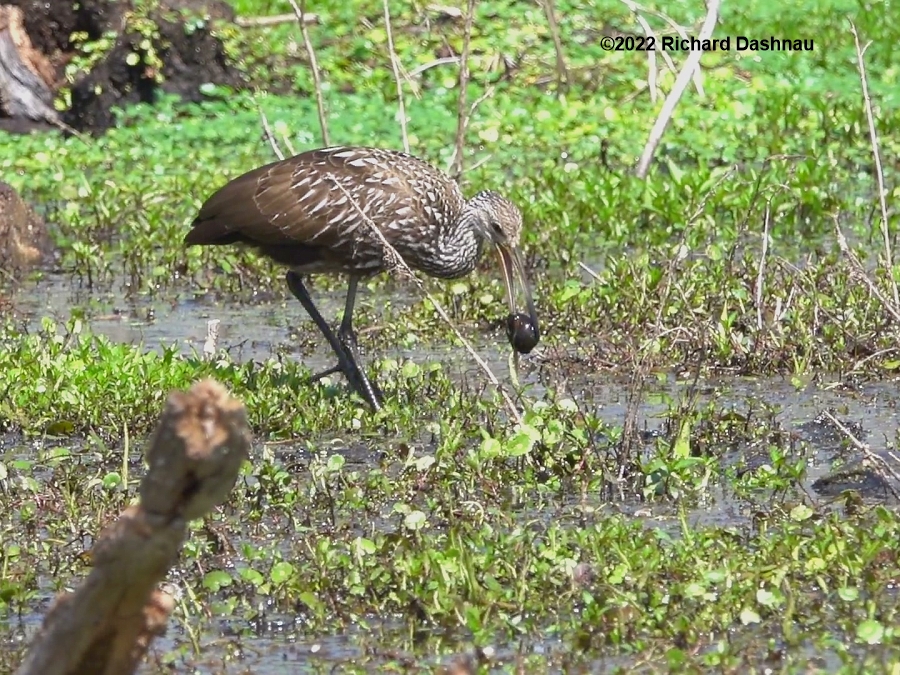
I've tried to
pierce Apple Snails by stabbing them with the point of a
smooth flounder gig. The shell is round and hard--and
difficult to pierce with a single point. If the point wasn't
thrust just right,
it slid off the shell, and the snail rolled away. But
this Limpkin was an expert, and pierced the shell after a
handful of hits. I was not close to the Limpkin, so
couldn't get a great view of its technique.
There's a a bit of manipulation needed to get the snail out of
the shell. It's interesting that the feeding strategy
doesn't include shattering the shell into pieces. There
was rapid back and forth
head-twisting motion, just before the snail is taken out. And
then the end of an invasive snail.

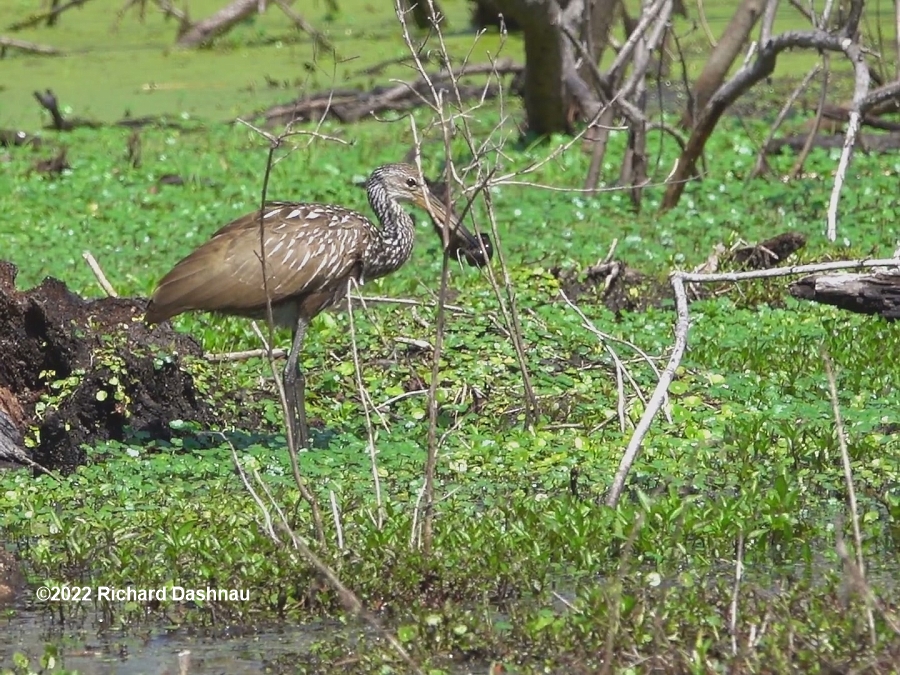
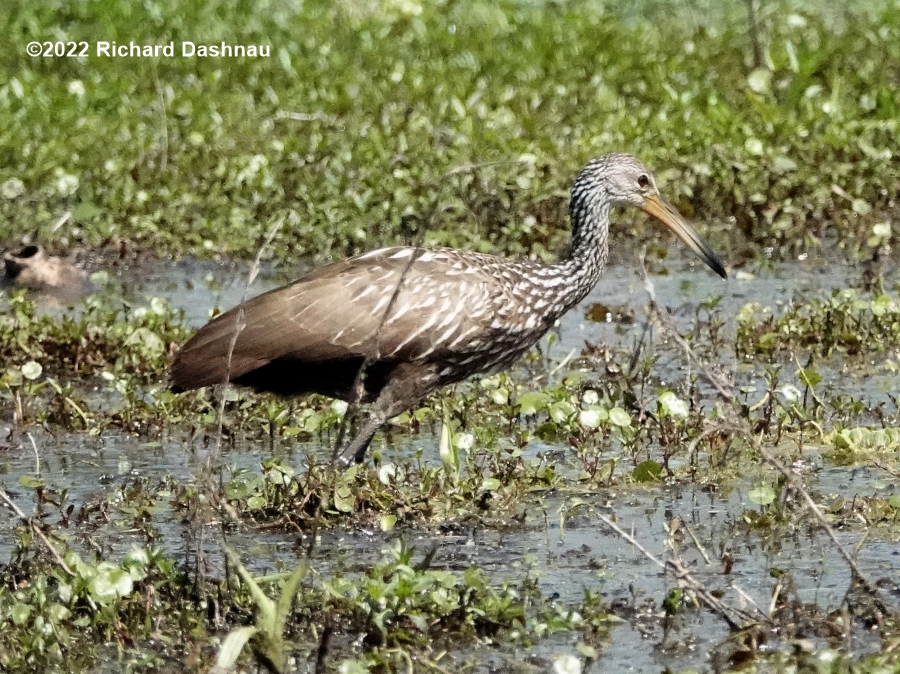

Even
with
wide feet, the Limpkin was too heavy for some plant mats. It
continued working as it sank into the water, then hopped to
the next mat. I saw this Limpkin eat at least 5 snails
in 30
minutes. The probing seems to be random. How can a
Limpkin tell when it has found a snail? It must be contacting
other hidden objects, sticks, etc., with its beak. But
it seemed to ignore
them in these very quick contact probes. But with
positive snail contact, the Limpkin starts working at the
snail. One snail took more effort, and the Limpkin
had to do a lot of twisting to get it
out of the plants. What was the snail holding on to? The
Limpkin seemed to be a bit surprised,. Again, The video clip is here.
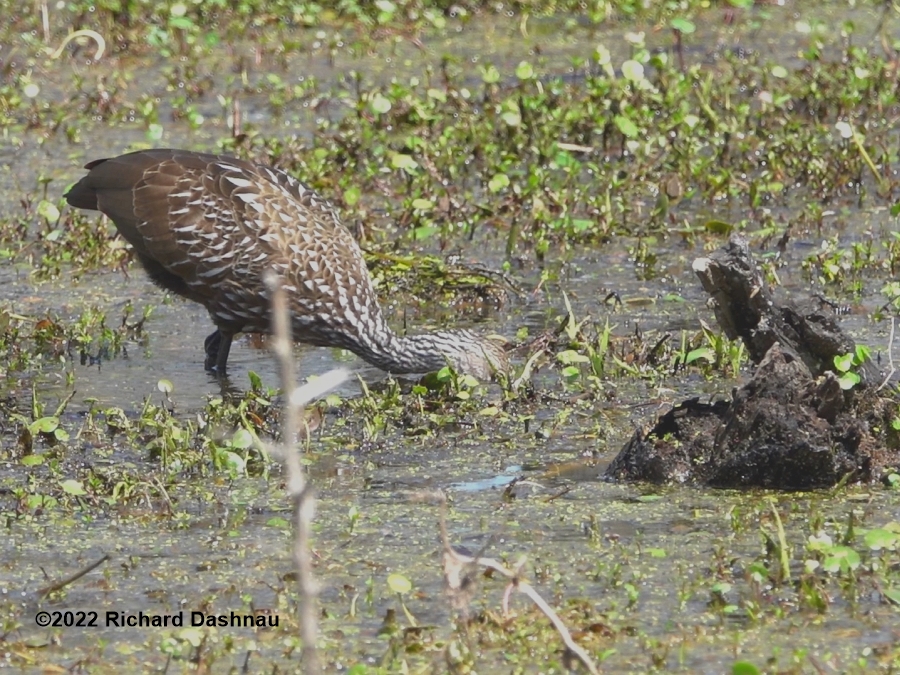

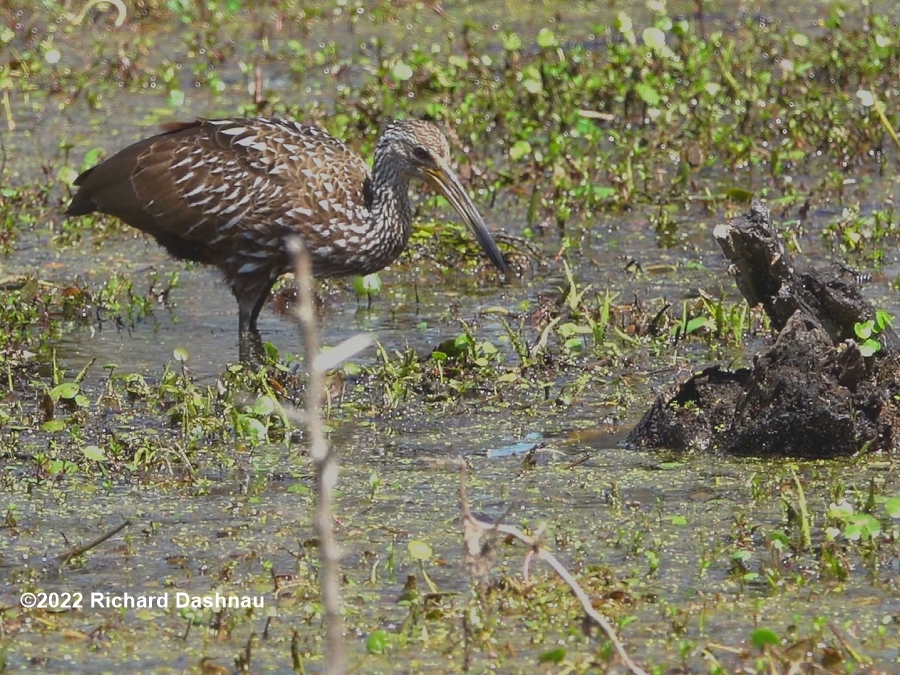

The
egg
masses of Apple Snails (Pomacea sp.) are toxic. The
glands that provision the snail eggs (albumin glands) inside
the snail are also toxic.(more details are on my
Pomacea Page).
There are multiple reports that describe how the snails'
predators discard these glands. ( since Oct. 2021 I've found
more reports that describe this behavior) Discarded glands
have been
seen in snail detritus left by Raccoons. (Observations of
Raccoon (Procyon lotor) Predation on the Invasive Maculata
Apple Snail (Pomacea maculata) in Southern Louisiana by
J. Carter et. al (page N15.)
Removal of these glands by Limpkins is mentioned in " Defenses
of the Florida Apple Snail Pomacea
paludosa by Noel F. R. Snyder and Helen A. Snyder
(1971)(page 177)" and by Snail Kites in
"Mollusk Predation by Snail Kites in Columbia Noel F. R.
Snyder and Herbert W. Kale" 1982 (page 97)
Nothing pink showed in the meals I watched, but that is
inconclusive. They could have been hidden inside the
body. I took the last picture on Live Oak trail in
2021. The shell shows twin punctures,
which are evidence of Limpkin predation. The pink mass above
the shell is a discarded albumin gland. I hope to catch
this behavior on film.
The snails are still here in the park. It was great to finally
see Limpkins hunting; but bad news that there are so
many snails inside BBSP.



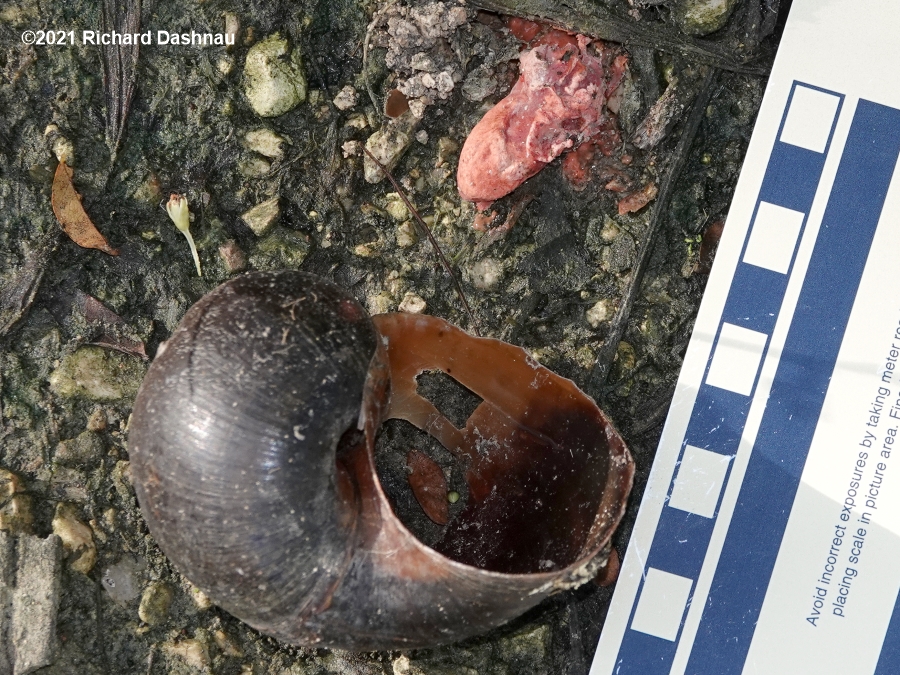
Update 04/04/2022 - From BBSP on
10/24/2021. On
Live Oak trail October 2021. I was still trying to see
more Limpkins, and hoped to see them foraging. I also hoped to
see any other
animals-Alligators, or Raccoons-going after the Apple Snails,
but no luck there. I did see and hear this Limpkin, and
the call was not the "crying" sound that I'd hear before. I
recorded the call.
Since then, I've learned that Limpkins have different calls
(like other birds do) and this was probably a female Limpkin.
I got the call on video, and The video clip is here.





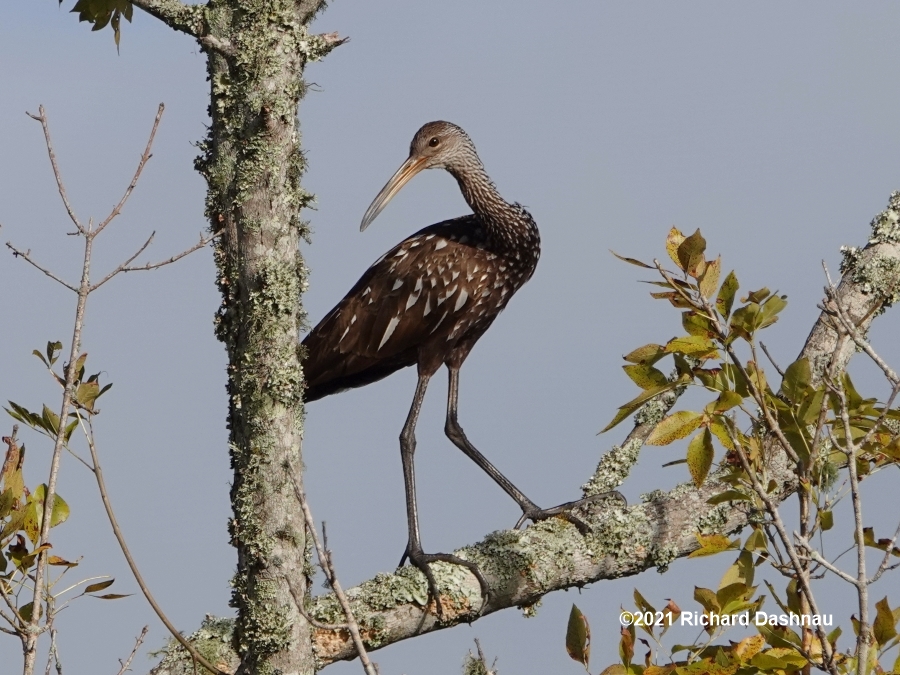

07/25/2021 and
08/01/21-
I've
been
doing more research on our apple snail invaders since July. When I saw
the inside of an adult Pomacea, I noticed orange masses or organs.
I figured that those were eggs. Since the deposited egg masses are
toxic, I wondered if the eggs inside the snail were also toxic. And, if
the eggs are toxic--how can any animals
--such as Limpkins--eat the adult snails? After a lot of
searching, I couldn't find any detailed description of how this
situation is dealt with. The first picture below was
taken on 7/24/21, but I'd seen inside other snails before then.
The other two pictures were taken 7/10/21, and show a snail that
something had eaten. At the time, I hadn't
realized that the toxic egg masses had been left inside the shell.



I found a number of
references saying that animals that eat the snails discard the albumen
glands. But the only predator I saw named
doing this was Snail Kites. But no clear descriptions.
I started searching for proof that Limpkins
might discard these organs. I found a video on youtube that shows a
Limpkin doing this! After that, I started looking around BBSP for
signs
of this behavior.
But let's pause a bit. Limpkins? Limpkins (Aramus guarauna)
are long-necked wading birds with long, pointed beaks. They're about the
size of Night Herons (maybe a bit larger).
According to Avibase, the World Bird Database, it is the only extant species
in the genus Aramus and the family Aramidae. The "home range" of 4
subspecies of Limpkins is: Florida, Cuba,
Jamaica ; southern Mexico south to western Panama;
Hispaniola and Puerto Rico; central and eastern Panama; South America,
south west of the Andes to western Ecuador, and east of the Andes
south to northern Argentina. Like many wading birds, Limpkins can be
generalist predators but according to many sources, the greatest
component of their diet is: Apple Snails. If we examine the
list of regions in their "home range", we can see something
missing-- TEXAS.
That's
right. In fact, their home range is far
from Texas.
Texas is now being invaded by Apple Snails. If only Limpkins were
in Texas! Well...they ARE in Texas. In fact, they have been
hanging around in the lake next door to BBSP for some months
now.
That lake is infested with snails. Unfortunately, the snails have made
their way to the BBSP side of the fence, along Live Oak Trail. But the
Limpkins have been picking them off there, also.
Discarded snail shells litter the trail. I went down Live Oak Trail on
7/18, and I saw something interesting among some discarded shells. I
took a few pictures. Next to one
of the shells is a pink mass. I think that mass is one of the "albumen
glands" that was discarded by the Limpkin that ate that snail. The trail
was really wet, so I didn't go further.
First 3 images below show shells on the trail, and a pink mass neer
them. The last image was taken there on 8/1/21, and shows pink material
in the discarded shell.
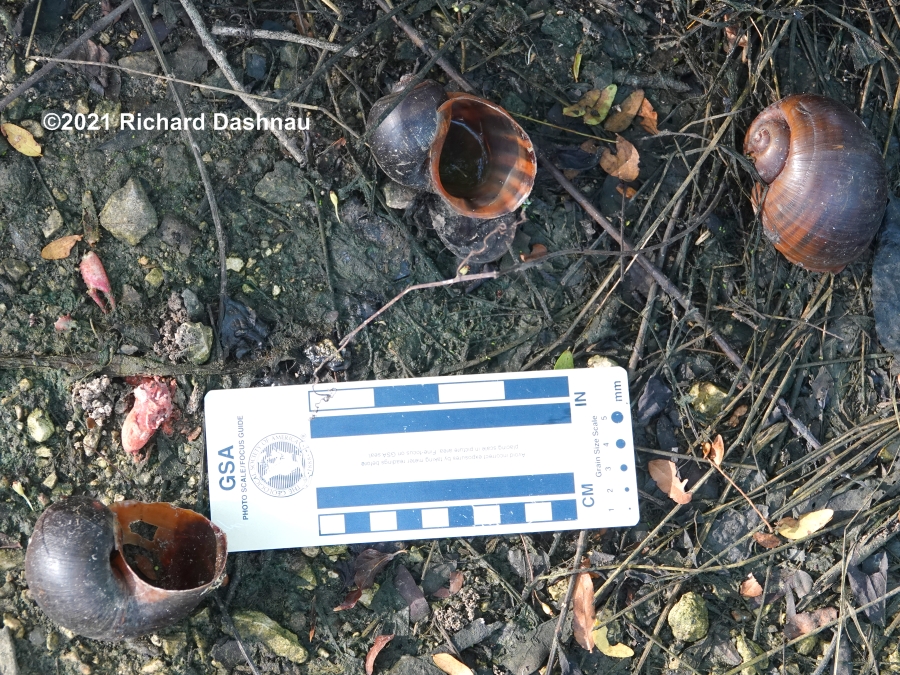

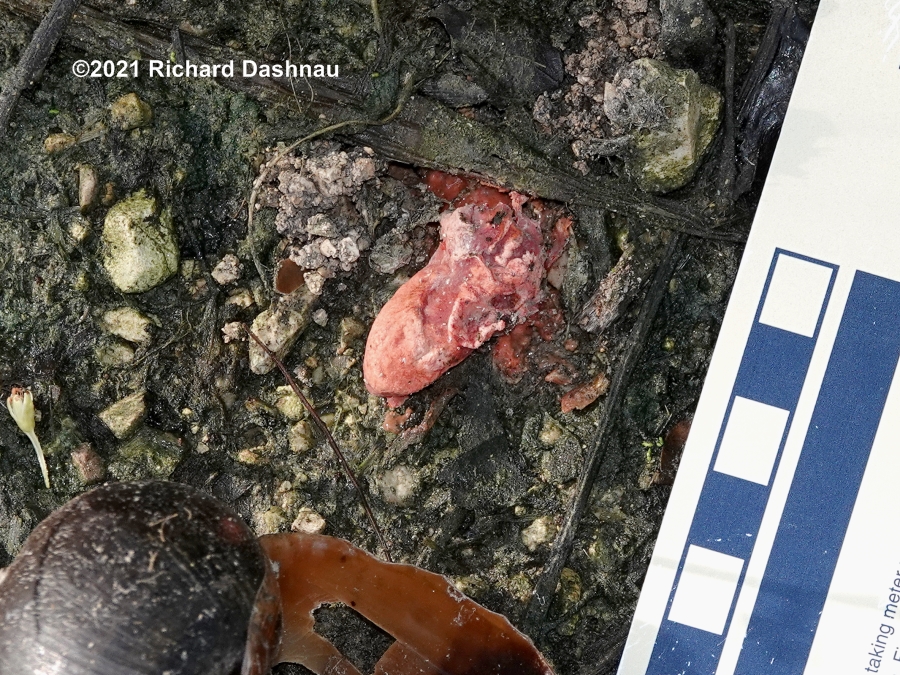
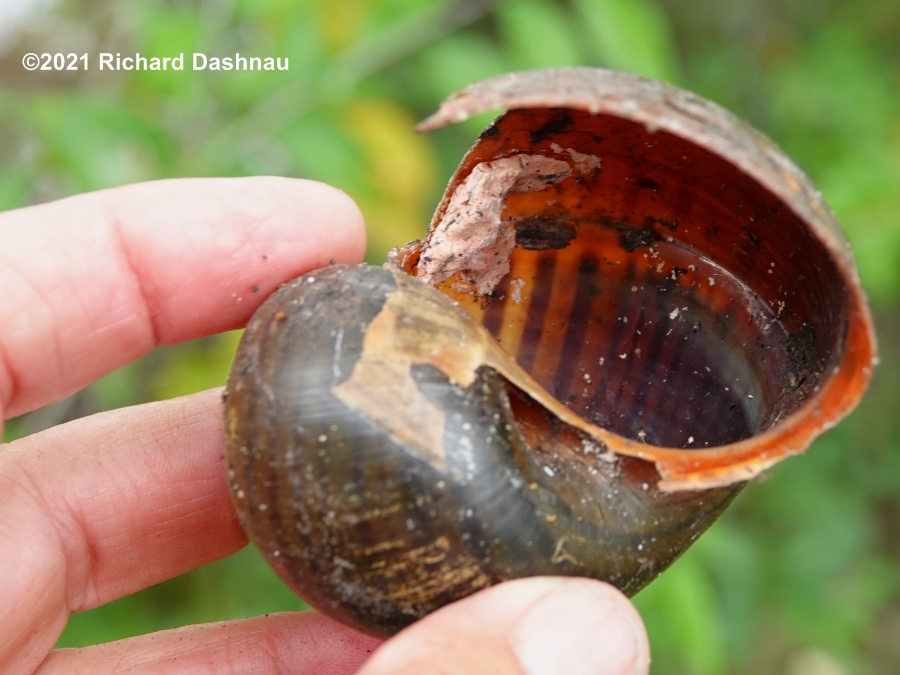
I returned to Live
Oak Trail the next week (7/25). I'd been around the other trails,
and entered Live Oak from the East end and walked West. I was
doing snail egg removal. It was Noon,
and it was hot, so I didn't expect to see anything. A Limpkin
appeared on the South side of the trail, near the fence, and hunted the
area near the fence. I stayed back, and hardly moved.
It came to the trail, walked on it a bit, then went back under the fence
and eventually up the levee and across. I got pictures and a bit
of video! This is all edited into this video.
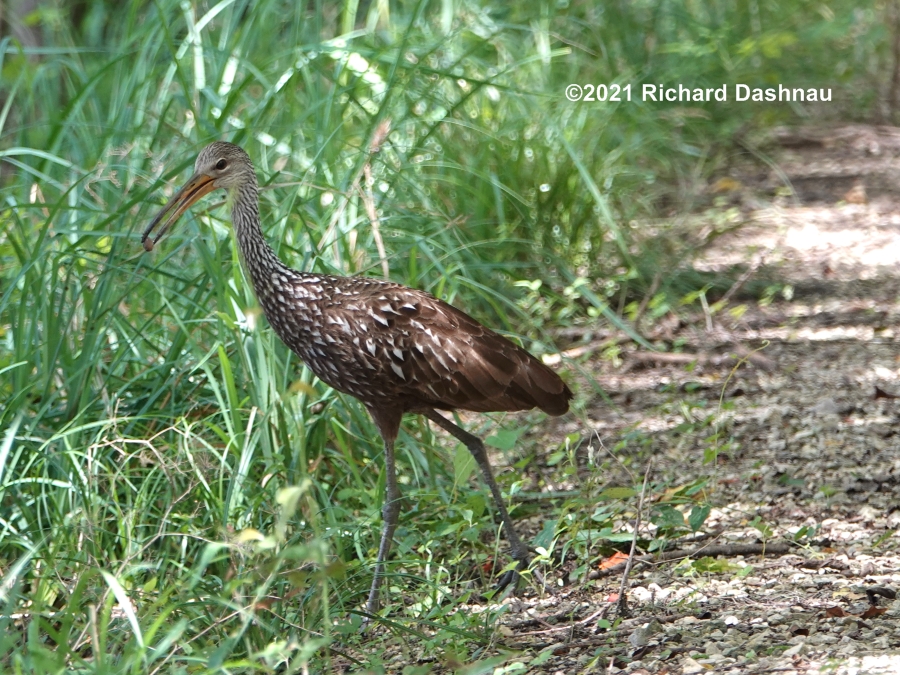
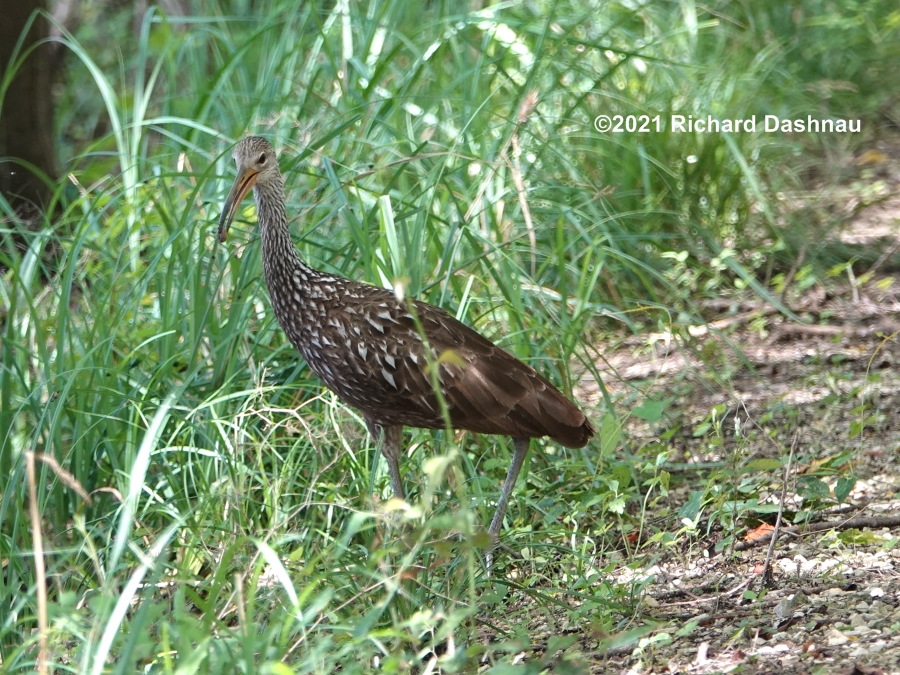
Next weekend
(8./01). I'd been out on the other trails first. I met a couple park
visitors I'd sent to Live Oak trail and they told me they'd hadn't seen
any Limpkins, but had seen snail egg masses,
and even a few live snails. So I was on Live Oak Trail again, at
about 12:30pm. I'd gotten almost to one of the "bridges" when I
saw a Limpkin up in a tree between the trail and the
road--that is, North of the trail. I watched it for about 20 minutes,
until thunder from approaching rain clouds convinced me to start back to
my car. I got a brief look at another Limpkin
in a tree near the one I'd been watching. They both moved, and
seemed to start hunting, but I didn't want to get caught in rain that
seemed to be approaching. I got photos and video
clips. Again, this has all been edited into this video.


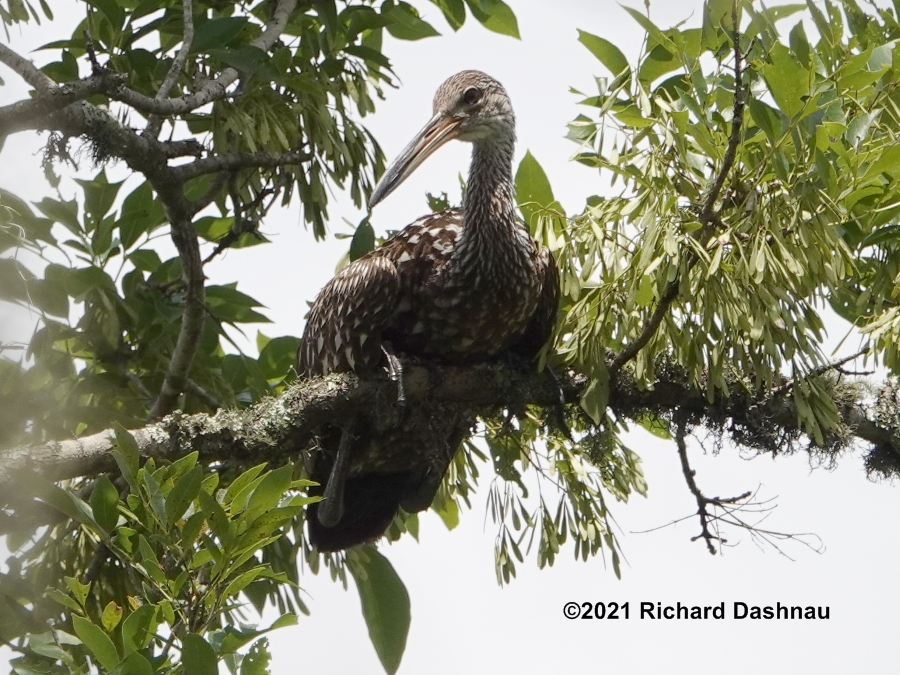

And, I found
another snail shell that seemed to have remnants of a discarded "albumen
gland" in it. I also found another paper that seems to have been
inspired by the habit of snail predators
discarding the "albumen gland": "Apple
Snail Perivitellin Precursor Properties Help Explain Predators’
Feeding Behavior" 2016 by Cadierno, Dreon, Heras. While it
discusses Pomacea canaliculata and
not our problem (P. maculata), I think it's still related. This
study is where I got the term "albumen gland" for the organ which
produces the snail eggs. Perivitellin
serves as a nutrition source for snail
embryos (similar function to egg yolk ). While the paper is a bit
technical for me to fully understand, for me it verified: a)
that the organs are
toxic, and therefore consumption of the entire snail
could be dangerous; b) that experienced predators do
discard toxic parts of the snail, rendering it safe to eat. From the
paper: " Therefore, as the noxious
perivitellin precursors are exclusively
confined within the AG, this
explains why it is the only usually discarded organ, even when this
behavior implies a large loss of the total energy and nutrients
available from the soft-body biomass
(Estoy et al. 2002). Finally, we
propose that the reddish-pink gland color may contribute to this
behavior, helping the visual-hunting predators of adult snails to
associate the bright AG color with the
noxious compounds it carries."(page
466 "AG"=albumen gland) This could be trouble for our
local predators (such as alligators) that might consume entire
snails. Raccoons might be able to identify
and remove the glands, but they'd have to learn about the danger first
(that might be what ate the snail in the picture above). It's
potentially good news that Limpkins are eating snails here. It will
be better news if they establish a breeding population in Texas. They
can help control the spread of the Pomacea. But, regardless of
predation, and it seems to me that the snails will remain. I think
the most we can hope for is that the predators that have followed the
snails (and other local predators) and the snails will reach a "balance"
where the snails will not overpower the environment.
There must be reasons why Limpkins haven't made the journey here before.
If lack of snails was a factor...where they're here now.
But, if there are other environmental reasons (such as temperature)
the Limpkins may not stay. I hope they do.
Go back to my home page, Welcome to rickubis.com
Go to the RICKUBISCAM
page.


























































































